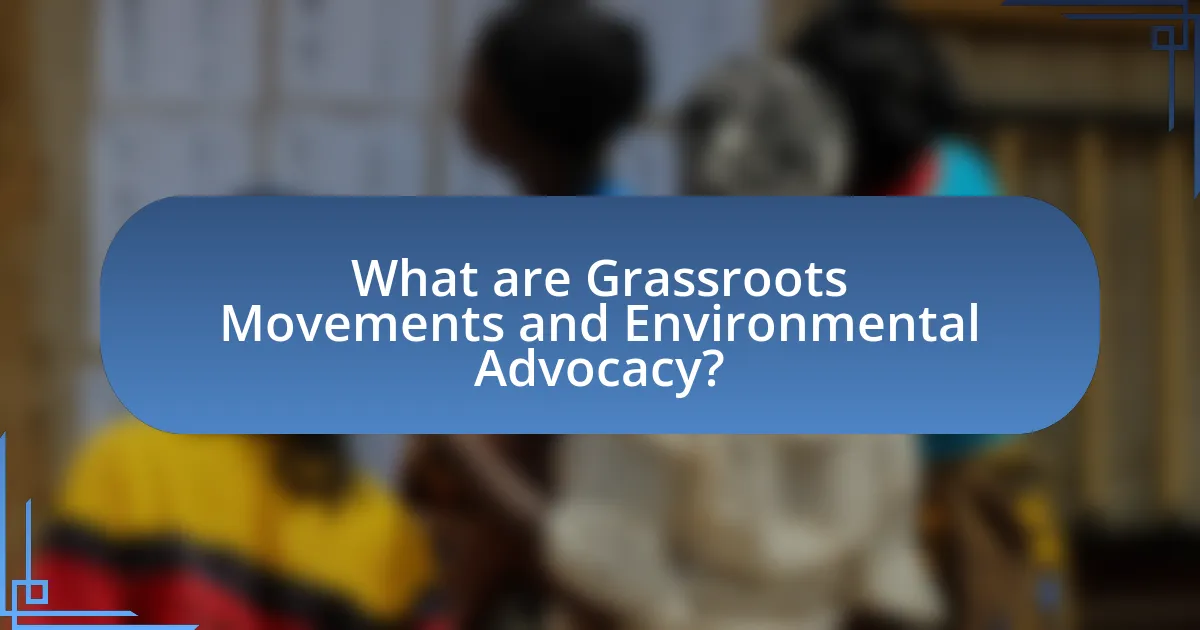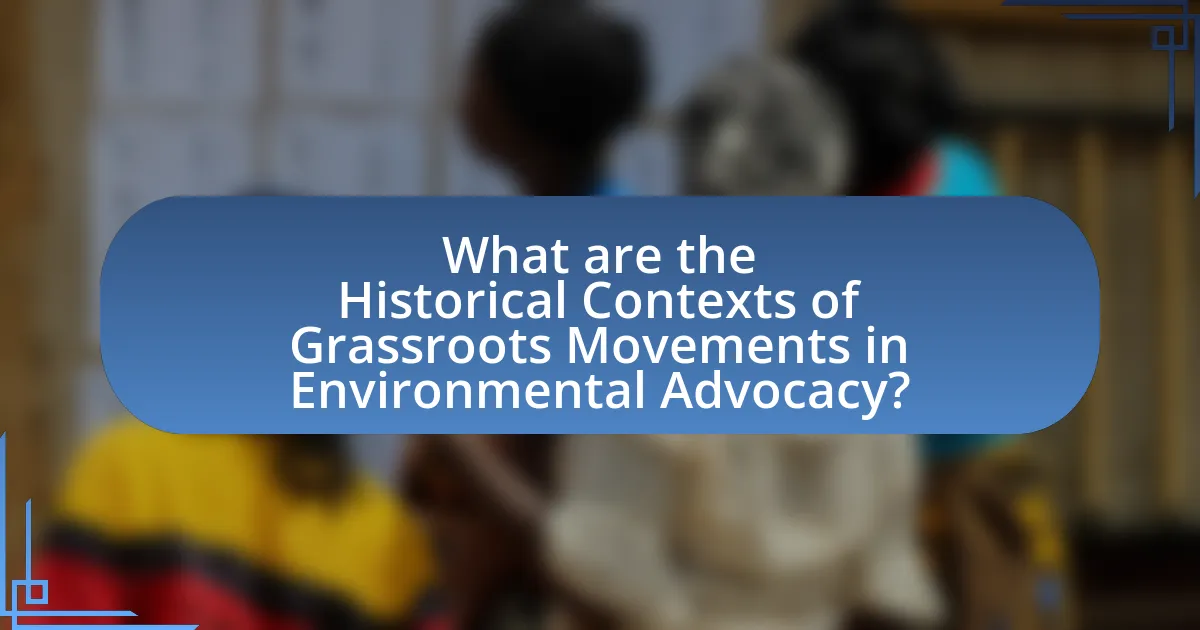Grassroots movements are community-driven initiatives that mobilize individuals to advocate for social or political change, particularly in environmental advocacy. This article explores the significant role grassroots movements play in raising awareness, influencing policy, and fostering local engagement in environmental issues. It examines the characteristics of these movements, their historical context, and how they have evolved over time, highlighting key events and figures that have shaped environmental advocacy. Additionally, the article discusses current trends, challenges faced by grassroots initiatives, and best practices for effective participation in environmental advocacy.

What are Grassroots Movements and Environmental Advocacy?
Grassroots movements are community-driven initiatives that mobilize individuals at the local level to advocate for social or political change, often focusing on issues like environmental protection. Environmental advocacy specifically refers to efforts aimed at promoting policies and practices that protect the environment and address climate change. These movements often emerge in response to perceived injustices or environmental degradation, utilizing strategies such as community organizing, public demonstrations, and lobbying to influence decision-makers. For instance, the 2019 global climate strikes, inspired by youth activists, exemplify how grassroots movements can effectively raise awareness and drive policy discussions on environmental issues.
How do grassroots movements contribute to environmental advocacy?
Grassroots movements significantly contribute to environmental advocacy by mobilizing local communities to take action on environmental issues. These movements often raise awareness about specific environmental challenges, such as pollution or deforestation, and empower individuals to participate in advocacy efforts. For instance, the 2019 climate strikes, initiated by youth activists, demonstrated how grassroots organizing can lead to global attention on climate change, resulting in increased public discourse and policy discussions. Additionally, grassroots movements often influence legislation by lobbying local governments and creating petitions, which can lead to tangible policy changes, as seen in various local bans on single-use plastics driven by community initiatives.
What are the key characteristics of grassroots movements?
Grassroots movements are characterized by their community-driven nature, emphasizing local participation and collective action. These movements typically arise from the needs and concerns of ordinary people rather than top-down directives from established organizations or authorities. They often focus on social, political, or environmental issues, mobilizing individuals to advocate for change through grassroots organizing, which includes rallies, petitions, and community meetings.
Additionally, grassroots movements are marked by their emphasis on inclusivity and diversity, seeking to represent a wide range of voices and perspectives within the community. They rely on grassroots funding and support, often eschewing large corporate donations to maintain independence and authenticity. Historical examples, such as the Civil Rights Movement and the environmental justice movement, illustrate how grassroots initiatives can effectively challenge systemic issues and drive significant societal change.
How do grassroots movements mobilize communities for environmental causes?
Grassroots movements mobilize communities for environmental causes by fostering local engagement and collective action. These movements often utilize strategies such as community organizing, education, and advocacy to raise awareness about environmental issues. For instance, the Sierra Club’s grassroots campaigns have successfully mobilized thousands of volunteers to participate in local conservation efforts, demonstrating the effectiveness of community-driven initiatives. Additionally, research indicates that grassroots movements can significantly influence policy changes; a study by the University of California found that local activism led to the implementation of stricter environmental regulations in several states. This evidence underscores the power of grassroots movements in galvanizing community support and driving meaningful environmental action.
Why is environmental advocacy important in today’s society?
Environmental advocacy is crucial in today’s society because it addresses urgent issues such as climate change, biodiversity loss, and pollution, which threaten public health and the planet’s ecosystems. The increasing frequency of extreme weather events, attributed to climate change, underscores the need for collective action to mitigate these impacts. For instance, the Intergovernmental Panel on Climate Change (IPCC) reports that global temperatures have risen by approximately 1.1 degrees Celsius since the late 19th century, leading to more severe natural disasters. Furthermore, environmental advocacy mobilizes communities to push for sustainable policies and practices, fostering grassroots movements that can influence legislation and corporate behavior. This grassroots engagement is vital, as studies show that local initiatives often lead to more effective environmental solutions tailored to specific community needs.
What are the main goals of environmental advocacy?
The main goals of environmental advocacy are to promote sustainable practices, protect natural resources, and influence policy changes for environmental protection. Environmental advocacy aims to raise awareness about ecological issues, mobilize communities for action, and hold corporations and governments accountable for environmental degradation. For instance, organizations like Greenpeace and the Sierra Club work to combat climate change and preserve biodiversity through campaigns and lobbying efforts, demonstrating the effectiveness of grassroots movements in achieving these goals.
How does environmental advocacy impact policy and legislation?
Environmental advocacy significantly influences policy and legislation by mobilizing public support and shaping political agendas. Advocacy groups raise awareness about environmental issues, which can lead to increased public pressure on lawmakers to enact sustainable policies. For instance, the 2016 Paris Agreement was heavily influenced by grassroots movements and environmental organizations that highlighted the urgency of climate change, resulting in commitments from various countries to reduce greenhouse gas emissions. Additionally, studies show that regions with active environmental advocacy see more robust environmental regulations, as these groups often provide research, expert testimony, and lobbying efforts that inform and persuade policymakers.

What are the Historical Contexts of Grassroots Movements in Environmental Advocacy?
Grassroots movements in environmental advocacy have historical contexts rooted in the rise of environmental awareness during the 20th century, particularly in the 1960s and 1970s. The publication of Rachel Carson’s “Silent Spring” in 1962 catalyzed public concern about pesticide use and environmental degradation, leading to the first Earth Day in 1970, which mobilized millions and highlighted grassroots activism. Additionally, the establishment of organizations like Greenpeace in 1971 exemplified how local efforts could address global environmental issues, emphasizing community involvement and direct action. These movements often emerged in response to industrial pollution, urbanization, and government inaction, reflecting a growing recognition of the need for sustainable practices and environmental justice. The historical context of these movements illustrates a shift from top-down environmental policy to community-driven initiatives, demonstrating the power of collective action in shaping environmental policy and awareness.
How have grassroots movements evolved over time?
Grassroots movements have evolved from localized, community-driven initiatives to more organized, global networks that leverage technology and social media for broader impact. Initially, these movements focused on specific local issues, such as labor rights or civil rights, often relying on face-to-face interactions and traditional media for mobilization. Over time, the advent of the internet and social media platforms has transformed grassroots activism, enabling rapid information dissemination and the ability to connect with like-minded individuals across the globe. For instance, the environmental movement has seen significant evolution, with campaigns like Earth Day in 1970 growing into global initiatives like the Fridays for Future movement, which mobilizes millions of young people worldwide to advocate for climate action. This shift illustrates how grassroots movements have adapted to changing societal contexts and technological advancements, enhancing their reach and effectiveness in addressing complex issues.
What significant events have shaped grassroots environmental movements?
Significant events that have shaped grassroots environmental movements include the establishment of Earth Day in 1970, which mobilized millions to advocate for environmental protection, and the Love Canal incident in the late 1970s, where residents organized against toxic waste dumping, leading to the Superfund law. Additionally, the 1980s saw the rise of the environmental justice movement, highlighting the disproportionate impact of environmental hazards on marginalized communities. The 1992 Earth Summit in Rio de Janeiro further galvanized global grassroots efforts by emphasizing sustainable development. Each of these events catalyzed community engagement and policy changes, demonstrating the power of collective action in environmental advocacy.
How have historical figures influenced grassroots environmental advocacy?
Historical figures have significantly influenced grassroots environmental advocacy by serving as catalysts for awareness and action. For instance, Rachel Carson’s publication of “Silent Spring” in 1962 raised public consciousness about pesticide use and its environmental impacts, leading to the modern environmental movement. Similarly, figures like John Muir, who co-founded the Sierra Club in 1892, advocated for the preservation of wilderness, inspiring grassroots efforts to protect natural spaces. These historical leaders not only provided foundational ideas but also mobilized communities, resulting in significant policy changes such as the establishment of national parks and the passage of environmental legislation like the Clean Air Act and the Clean Water Act. Their legacies continue to empower contemporary activists and organizations in their efforts to address environmental issues at the local level.
What role did grassroots movements play in major environmental legislation?
Grassroots movements have been pivotal in shaping major environmental legislation by mobilizing public support, raising awareness, and influencing policymakers. For instance, the environmental movement of the 1960s and 1970s, exemplified by events like Earth Day in 1970, galvanized millions of individuals to advocate for environmental protection, leading to significant legislative outcomes such as the Clean Air Act of 1970 and the Clean Water Act of 1972. These movements utilized grassroots organizing strategies, including protests, community education, and lobbying, to create a sense of urgency around environmental issues, ultimately compelling legislators to enact laws that addressed pollution and conservation. The success of these initiatives demonstrates the effectiveness of grassroots activism in driving legislative change and fostering a culture of environmental stewardship.
Which landmark laws were influenced by grassroots activism?
Landmark laws influenced by grassroots activism include the Clean Air Act of 1970 and the National Environmental Policy Act (NEPA) of 1969. The Clean Air Act was significantly shaped by public concern over air pollution, which was mobilized by grassroots organizations like the Sierra Club and local community groups advocating for cleaner air. NEPA emerged from widespread activism that highlighted the need for environmental considerations in federal decision-making, driven by grassroots campaigns that emphasized the importance of public participation in environmental assessments. These laws reflect the power of grassroots movements in shaping environmental policy and legislation.
How did grassroots movements respond to environmental crises?
Grassroots movements responded to environmental crises by mobilizing communities to advocate for sustainable practices and policy changes. These movements often organized protests, campaigns, and educational initiatives to raise awareness about environmental issues such as climate change, pollution, and deforestation. For instance, the 2019 global climate strikes, inspired by youth activists like Greta Thunberg, saw millions participate worldwide, demonstrating the power of grassroots mobilization in addressing urgent environmental concerns. Additionally, local organizations frequently engage in direct action, such as tree planting and clean-up drives, to foster community involvement and promote environmental stewardship.

What are the Current Trends in Grassroots Movements and Environmental Advocacy?
Current trends in grassroots movements and environmental advocacy include increased digital mobilization, intersectionality in activism, and a focus on local solutions. Digital platforms enable rapid organization and outreach, allowing movements like Fridays for Future to gain global traction. Intersectionality emphasizes the interconnectedness of social justice and environmental issues, as seen in movements advocating for marginalized communities affected by climate change. Additionally, grassroots initiatives are increasingly prioritizing localized, community-driven solutions, such as urban gardening and renewable energy cooperatives, which empower individuals and foster resilience against environmental challenges. These trends reflect a shift towards more inclusive and adaptive approaches in the fight for environmental justice.
How are technology and social media shaping grassroots movements today?
Technology and social media are fundamentally transforming grassroots movements by enhancing communication, mobilization, and fundraising capabilities. These platforms allow activists to quickly disseminate information, organize events, and rally support on a global scale. For instance, the use of Twitter and Facebook during the Arab Spring in 2011 exemplified how social media can facilitate rapid mobilization and coordination among diverse groups, leading to significant political change. Additionally, a 2020 study by the Pew Research Center found that 69% of Americans believe social media is an effective tool for raising awareness about social issues, highlighting its role in amplifying grassroots efforts. This integration of technology enables grassroots movements to reach wider audiences, engage supporters in real-time, and foster community solidarity, ultimately driving more impactful advocacy for environmental causes.
What platforms are most effective for grassroots environmental campaigns?
Social media platforms, particularly Facebook, Twitter, and Instagram, are the most effective for grassroots environmental campaigns. These platforms enable rapid information dissemination, community engagement, and mobilization of supporters. For instance, a study by the Pew Research Center found that 69% of adults in the U.S. use Facebook, making it a powerful tool for organizing events and sharing campaign messages. Additionally, Twitter’s real-time communication capabilities allow for immediate responses to environmental issues, while Instagram’s visual storytelling can effectively highlight environmental challenges and successes. These characteristics collectively enhance the reach and impact of grassroots environmental initiatives.
How do online movements translate into offline action?
Online movements translate into offline action through organized mobilization, community engagement, and strategic planning. Social media platforms facilitate awareness and connection among individuals who share common goals, leading to the formation of grassroots organizations that coordinate real-world events such as protests, clean-up drives, and advocacy campaigns. For instance, the global climate strikes initiated by the Fridays for Future movement, inspired by Greta Thunberg, saw millions of participants worldwide, demonstrating how online calls to action can result in significant offline participation. Research indicates that 75% of participants in such movements reported being motivated by online interactions, highlighting the effectiveness of digital platforms in fostering real-world activism.
What challenges do grassroots movements face in contemporary environmental advocacy?
Grassroots movements in contemporary environmental advocacy face significant challenges, including limited funding, political resistance, and fragmentation within the movement. Limited funding restricts their ability to mobilize resources effectively; for instance, a report by the Environmental Grantmakers Association indicates that grassroots organizations receive only a small fraction of overall environmental funding, which hampers their outreach and impact. Political resistance manifests through regulatory hurdles and opposition from powerful industries, as seen in cases where local activists confront fossil fuel companies. Additionally, fragmentation occurs when diverse groups pursue varying agendas, diluting collective efforts and weakening their overall influence. These challenges hinder the effectiveness of grassroots movements in driving meaningful environmental change.
How do funding and resources affect grassroots initiatives?
Funding and resources significantly impact grassroots initiatives by determining their operational capacity and outreach effectiveness. Adequate funding allows grassroots organizations to hire staff, conduct research, and implement programs, which enhances their ability to mobilize community support and influence policy. For instance, a study by the National Committee for Responsive Philanthropy found that organizations with stable funding are more likely to achieve long-term goals and create systemic change. Conversely, limited resources can hinder grassroots efforts, restricting their ability to engage with the community and sustain momentum. Thus, the availability of funding and resources is crucial for the success and sustainability of grassroots initiatives in environmental advocacy.
What strategies can grassroots movements employ to overcome obstacles?
Grassroots movements can employ strategies such as coalition-building, effective communication, and leveraging social media to overcome obstacles. Coalition-building allows these movements to unite diverse groups, increasing their collective power and resources, as seen in the success of the Climate Justice Alliance, which brings together various organizations to advocate for environmental justice. Effective communication helps articulate their goals and mobilize supporters, exemplified by the use of storytelling to connect with the public emotionally. Leveraging social media enables grassroots movements to reach wider audiences quickly, as demonstrated by the viral campaigns of movements like Fridays for Future, which mobilized millions globally for climate action. These strategies collectively enhance the resilience and impact of grassroots movements in the face of challenges.
What are best practices for engaging in grassroots environmental advocacy?
Best practices for engaging in grassroots environmental advocacy include building a strong community network, utilizing social media for outreach, and organizing local events to raise awareness. A strong community network fosters collaboration and amplifies voices, as evidenced by successful campaigns like the 2019 climate strikes, which mobilized millions globally through local grassroots efforts. Utilizing social media platforms allows advocates to share information quickly and engage a wider audience, demonstrated by the effectiveness of hashtags like #FridaysForFuture. Organizing local events, such as clean-up drives or educational workshops, not only raises awareness but also empowers community members to take action, as seen in initiatives like the Surfrider Foundation’s beach clean-ups that have led to significant local environmental improvements.
How can individuals effectively participate in grassroots movements?
Individuals can effectively participate in grassroots movements by engaging in local initiatives, advocating for policy changes, and mobilizing community support. Active involvement in local initiatives allows individuals to contribute directly to causes they care about, such as environmental advocacy, by organizing events, participating in clean-up drives, or joining local environmental groups. Advocating for policy changes involves educating oneself about relevant legislation and communicating with local representatives to influence decision-making. Mobilizing community support can be achieved through social media campaigns, organizing informational meetings, and collaborating with like-minded individuals to amplify their message. Research indicates that grassroots movements can significantly impact policy outcomes, as seen in the success of the 2019 climate strikes, which mobilized millions globally and influenced climate policy discussions.
What resources are available for grassroots environmental advocates?
Grassroots environmental advocates have access to various resources, including funding opportunities, training programs, and networking platforms. Organizations such as the Environmental Grantmakers Association provide financial support specifically for grassroots initiatives, while training programs offered by groups like the Sierra Club equip advocates with essential skills in advocacy and organizing. Additionally, platforms like Grassroots.org connect advocates with a network of like-minded individuals and organizations, facilitating collaboration and resource sharing. These resources are crucial for empowering grassroots movements and enhancing their effectiveness in environmental advocacy.


